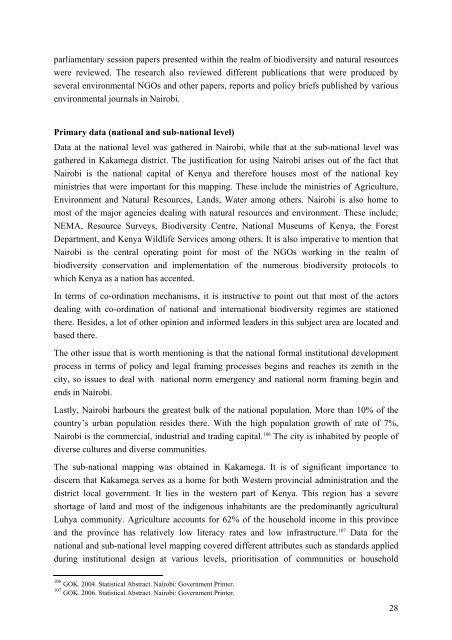THE UNIVERSITY OF LEIPZIG
THE UNIVERSITY OF LEIPZIG
THE UNIVERSITY OF LEIPZIG
You also want an ePaper? Increase the reach of your titles
YUMPU automatically turns print PDFs into web optimized ePapers that Google loves.
parliamentary session papers presented within the realm of biodiversity and natural resources<br />
were reviewed. The research also reviewed different publications that were produced by<br />
several environmental NGOs and other papers, reports and policy briefs published by various<br />
environmental journals in Nairobi.<br />
Primary data (national and sub-national level)<br />
Data at the national level was gathered in Nairobi, while that at the sub-national level was<br />
gathered in Kakamega district. The justification for using Nairobi arises out of the fact that<br />
Nairobi is the national capital of Kenya and therefore houses most of the national key<br />
ministries that were important for this mapping. These include the ministries of Agriculture,<br />
Environment and Natural Resources, Lands, Water among others. Nairobi is also home to<br />
most of the major agencies dealing with natural resources and environment. These include;<br />
NEMA, Resource Surveys, Biodiversity Centre, National Museums of Kenya, the Forest<br />
Department, and Kenya Wildlife Services among others. It is also imperative to mention that<br />
Nairobi is the central operating point for most of the NGOs working in the realm of<br />
biodiversity conservation and implementation of the numerous biodiversity protocols to<br />
which Kenya as a nation has accented.<br />
In terms of co-ordination mechanisms, it is instructive to point out that most of the actors<br />
dealing with co-ordination of national and international biodiversity regimes are stationed<br />
there. Besides, a lot of other opinion and informed leaders in this subject area are located and<br />
based there.<br />
The other issue that is worth mentioning is that the national formal institutional development<br />
process in terms of policy and legal framing processes begins and reaches its zenith in the<br />
city, so issues to deal with national norm emergency and national norm framing begin and<br />
ends in Nairobi.<br />
Lastly, Nairobi harbours the greatest bulk of the national population. More than 10% of the<br />
country’s urban population resides there. With the high population growth of rate of 7%,<br />
Nairobi is the commercial, industrial and trading capital. 106 The city is inhabited by people of<br />
diverse cultures and diverse communities.<br />
The sub-national mapping was obtained in Kakamega. It is of significant importance to<br />
discern that Kakamega serves as a home for both Western provincial administration and the<br />
district local government. It lies in the western part of Kenya. This region has a severe<br />
shortage of land and most of the indigenous inhabitants are the predominantly agricultural<br />
Luhya community. Agriculture accounts for 62% of the household income in this province<br />
and the province has relatively low literacy rates and low infrastructure. 107 Data for the<br />
national and sub-national level mapping covered different attributes such as standards applied<br />
during institutional design at various levels, prioritisation of communities or household<br />
106 GOK. 2004. Statistical Abstract. Nairobi: Government Printer.<br />
107 GOK. 2006. Statistical Abstract. Nairobi: Government Printer.<br />
28






